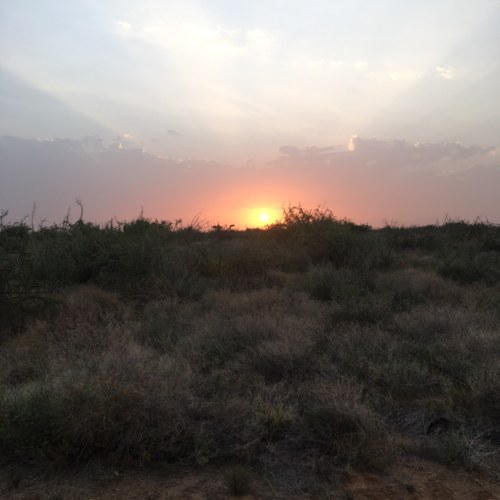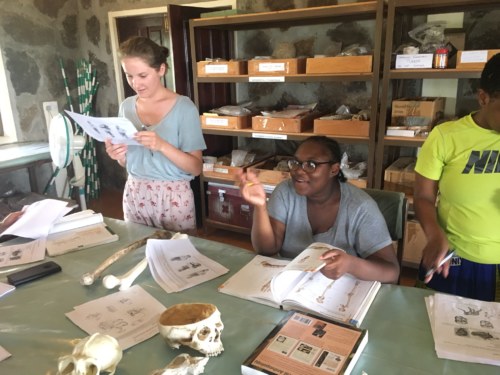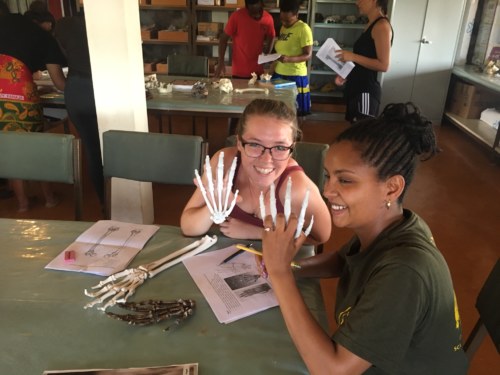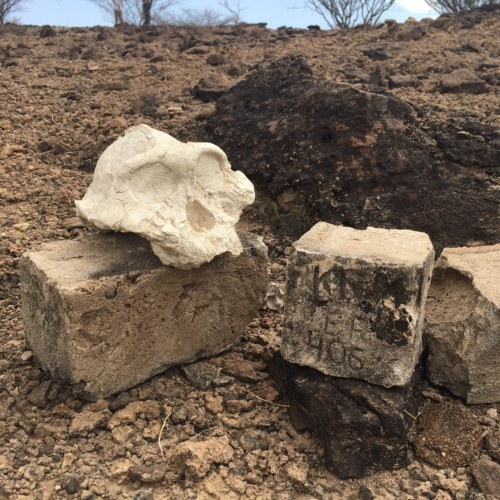During the past week the field school has been tracing back the origins of our own species with the Human Evolution module led by Dr. Tracy Kivell! Our days have been divided into morning lectures and afternoon lab sessions and so far we’ve covered skeletal anatomy, origins of bipedalism, and the very intricate story of early hominin evolution.

The sun rises in Turkana and another field school module begins! (Photo: Lucia Nadal)
Human and primate skeletal anatomy have been the starting point for the rest of the lectures, since they represent the basic building blocks of understanding the paleontological evidence of our lineage. They also allow us to think about the traits that set us apart from other primates and how far back in time we can trace those traits to.

Isabelle and Latay during the human and primate skeletal anatomy lab session. (Photo: Lucia Nadal).
One of these traits is the ability to walk in two feet, also known as bipedality, a uniquely human way of locomotion that has its origins millions of years ago. In 1994 a tibia found by Dr. Meave Leakey in the Turkana Basin made history by providing the oldest definitive evidence of hominin bipedalism! The proud owner of this tibia was an early hominin of the species Australopithecus anamensis who was walking around in two feet between 4.2 and 3.9 million years ago. This individual belonged to a group of hominins that shared a slender morphology, also known as ‘gracile Australopithecines’, and is believed to be the ancestor of our own lineage.

Students explore cranial anatomy of ‘gracile Australopithecines’ (Photo: Lucia Nadal).
The lectures on early hominins, have taken us through many different genera and species, highlighting the significant amount of diversity present in this group. One of the most puzzling groups of hominins are the ‘robust australopithecines’, with a striking morphology that sets them apart from their slenderer cousins. This lineage, grouped in the Paranthropus genus, shows remarkably big molar teeth and an overall massive cranial morphology that have been the center of debate and controversy for the past 5 decades.

Meaghan and Friyat study chimpanzee hand anatomy (Photo: Lucia Nadal)
This year marks the 50th anniversary of the discovery of the KNM-ER 406 skull, a landmark fossil in paleoanthropology and one of the most complete representatives of the ‘robust Australopithecines’. The historic skull belongs to the species Paranthropus boisei and it was discovered by Meave and Richard Leakey in the early days of exploration of the Turkana Basin in 1959. We couldn’t let this historic occasion pass without visiting the site, and on Friday the field school made a trip to Area 10 to locate the coordinates of where the cranium was first discovered. We brought a cast of the specimen along for the pilgrimage and imagined what it must have felt like to find this unique fellow looking back at us from the sand fifty years ago!

A cast of KNM-ER 406 rests next to the discovery site of this famous skull found 50 years ago. (Photo: Lucia Nadal)
With more hominin stories to review, the field school has a lot to cover in the next week, before moving to TBI Turwel on the West side of Lake Turkana for the final module of the field school. Stay tuned for more field school blogs to come!





